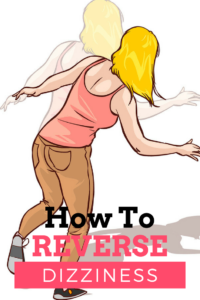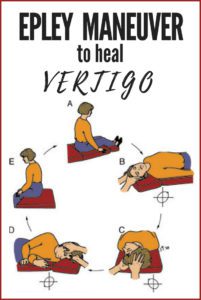Treating Vertigo: Balancing Fluid in the Ear
Republished November, 2020
How to Reverse Your Inner Ear Dizziness
Peter is a young man in his mid-forties without any health issues. He has three children, and he and his wife have been married for over twenty years. His job isn’t unusually stressful. He plays tennis every week, and has no problem keeping up with the ball. However, he came into the office with several months of dizziness and nausea. It comes and goes, and seems to happen mostly at night when he lies down, or in the morning when he wakes up. Sometimes dizziness will wake him up at night. He can work all day, including exercise without any symptoms.Vertigo is often confused with dizziness. Let’s look at all the different types of dizziness.
- Dizziness – the general term for feeling movement when there is none.
- Lightheadedness – what we feel when standing up too fast; a “head rush.”
- Giddiness – the sensation you get when you are at the top of the Empire State Building, and you look straight down.
- Presyncope – the feeling of almost passing out, usually including vision and hearing changes, or numbness and tingling.
- Disequilibrium – a lack of strength or stability from peripheral muscles and nerves.
- Anxiety – panic, a sense of impending doom.
- Vertigo – a specific feeling of spinning or movement in a certain direction, such as after being on a merry-go-round, and continuing to feel the spinning after stopping.
One of the problems is that these symptoms can overlap, so there isn’t a way to distinguish them well.
Vertigo
There are two primary types of vertigo.“Peripheral” or a problem with the fluid balance in the ear.
- “Central” or a problem with the nervous system, like the brain.
Peripheral Vertigo
A sensation of spinning can happen from the “vestibular system” in the inner ear. This is an amazingly tiny system of three circular canals that have fluid in them. As the fluid moves, a signal is sent to the brain that the body is moving.
This tiny sensory apparatus is absolutely brilliant in its simplicity and effectiveness! There are three little tubes in a circle that are oriented in three different directions. One is up-down, another is side-to-side, and the third is front-back.
Thus, any direction you move will cause the fluid inside the tubes to move. The fluid then moves a cluster of little sand crystals that push against hairs attached to nerve fibers that send a signal to the brain: “We’re moving in this direction!”
There are many different sized hairs in each – longer hairs trigger easier, while shorter hairs require more pressure. Thus, we can know if there is a little movement, or a lot. Moreover, the combination of impulses from the three canals can indicate any direction.
However, when the tiny amount of fluid in these canals changes and you are not moving, your brain still registers motion. When it happens in only one canal, it is usually a feeling of spinning. This is vertigo.
The best way to tell if vertigo is from the inner ear is if the sensation happens with a specific movement. Typically, someone might say, “Every time I turn to the left, I feel like I just got off a merry-go-round.” It may take anywhere from seconds to several minutes for the sensation to diminish or go away.
A note about nausea…some people get nausea when they have sensations of movement and they aren’t moving. This is the basis for seasickness and other motion sickness. On the boat, everything looks stable so the eyes are sending a message of no movement. But the inner ear, the vestibular system, is telling the brain that you’re moving. This conflict often results in sickness. Some people are very sensitive to the eye-ear connection, and others can tolerate more conflict.
Thus, when some people get even tiny amounts of vertigo, even riding a roller-coaster, Ferris wheel, or merry-go-round, it can elicit nausea and vomiting. Some people with vertigo will do anything to stop it because they feel sick every time it happens. Thus, they will only turn their heads very slowly, or only in one direction.
Causes of Peripheral Vertigo
Anything that changes the nature or movement of the fluid in the inner ear can cause peripheral vertigo[1]. This fluid is connected to the “cochlea” or the organ that translates sound waves into nerve impulses. Peripheral vertigo can be caused by:
- Loud noises that vibrate the fluid in the inner ear, producing a sensation of movement.
- Inflammation of any kind changes the nature and amount of fluid in the canals, or affects the crystals.
- Injury from head and neck trauma or tumor growths can create vertigo symptoms.
- Viral infections, such as herpes, or shingles are common, causing fluid shifts and inflammation.
- Bacterial infections such as syphilis were a common cause of peripheral vertigo, but are now rare since we use antibiotics.
- Fluid shifts – the balance between the cells that make the fluid and the ones that reabsorb it.
- Changes in the vestibular apparatus, such as plugging of the canal with calcium deposits, or the calcium crystals sticking together. It is thought that sometimes the crystals get “stuck” against the hair trigger of a nerve, causing it to be jammed in the “on” position.
Vertigo Treatment
Of course, the treatment of vertigo will depend on the cause. The most common cause called BPPV or Benign Paroxysmal Positional Vertigo seems to be caused by a displaced crystal in the inner ear. The treatment for this is called “Epley Maneuvers,” named after the doctor who developed it. These movements intend to relocate the crystals in your inner ear back to where they belong and are effective in about 90% of patients with BPPV[2].
Epley Maneuvers
The following sequence of positions describes the Epley maneuver[3]:
- Begin in an upright sitting position on a table with the legs fully extended and the head rotated 45 degrees towards the side that causes dizziness.
- Keeping your head rotated 45 degrees towards the dizziness side quickly lie down backwards with a pillow under your neck and shoulders. The pillow causes your neck to extend about 30-degrees with your head titled back.
- Remain in this position for approximately 1–2 minutes. If BPPV vertigo is present, eye twitching will occur.
- Now, rotate your head 90 degrees to the opposite direction so that the opposite ear faces the floor, all while maintaining the 30-degree neck extension.
- Remain in this position for approximately 1–2 minutes.
- Next, keeping the head and neck in a fixed position relative to the body, roll onto your shoulder. This will rotate your head another 90 degrees in the direction that you are facing. You are now looking downwards at a 45-degree angle.
- Remain in this position for approximately 1–2 minutes.
- Now, sit up, while maintaining the 45-degree rotation of the head.
- Hold the sitting position for up to 30 seconds.
- The entire procedure may be repeated two more times, for a total of three times.
During every step of this procedure you may experience some dizziness, which is normal.
You can watch a simple video to illustrate this procedure.
Following this procedure, it has been recommended to limit movement for one day, but it isn’t clear that this improves outcomes. The treatment is more than 90% effective for removing the cause of Benign Paroxysmal Positional Vertigo (BPPV).
Other causes of vertigo
When dizziness comes from the brain the symptoms may be the same, but the possible causes are very different. The symptoms of central vertigo[4] are rarely associated with position or movement. The most common cause is blood flow limitations such as migraine headaches.
Other causes of vertigo include:
- Tumors – one tumor found in the bony canal that connects the ear to the brain can put pressure on both the vestibular nerve and the auditory nerve causing both dizziness and hearing loss. Other tumors that may cause vertigo could be found in the cerebellum or thalamus.
- Arterial disease – this can be clogging of the arteries, strokes, or “vascular dissection” (splitting of the artery) in the brain.
- Ménière’s disease –This is a disease of the inner ear associated with vertigo, tinnitus, and hearing loss in one or both ears.[5]
- Multiple Sclerosis – this is a progressive degeneration in the central nervous system that can cause any sort of neurological symptoms, including numbness, weakness, pain, or loss of function of any sort.
Medical doctors have several different ways to distinguish different types of vertigo. I find it more useful to understand only two things:
- Is it benign (BPPV)? …something I can take care of myself?
- Or, is it something else and I need to begin searching for the cause?
The key to benign causes of vertigo that you can treat is the clear effect of position. If it only happens when you are in a certain position, such as lying down, turning your head to one side, and so forth, and it only lasts a short time, such as a couple of minutes, it’s likely to be benign. However, if the vertigo comes on randomly, is constant, or lasts for hours, even if it only happens with certain movements, it may be central vertigo.
Consult with a professional if the symptoms include:
- Headaches
- Pain in the ear
- Vomiting without nausea
- Hearing changes such as ringing (tinnitus), or loss of hearing – especially only in one ear.
- Numbness
- Weakness
- Difficulty walking
- Shaking, tremors
It is important to find the cause of central vertigo because it may not be benign. It’s not that these are “bad signs,” however you just need to know the cause. Migraine headaches, for example, are a common cause of central vertigo, and aren’t a threat. The treatment of central vertigo will entirely depend on the cause.
Peter has a classic case of BPPV, which only happens when he is lying down, and lasts for only a few minutes. In his case, a simple series of Epley Maneuvers fixed the problem and he could go on with his busy life.
As you can see, vertigo is a symptom with many different possible causes, and treatments. However, by far, the most common causes of vertigo are not dangerous or worrisome. Moreover, the treatment for the most common cause is simple to do at home, and brings permanent relief most of the time.



























